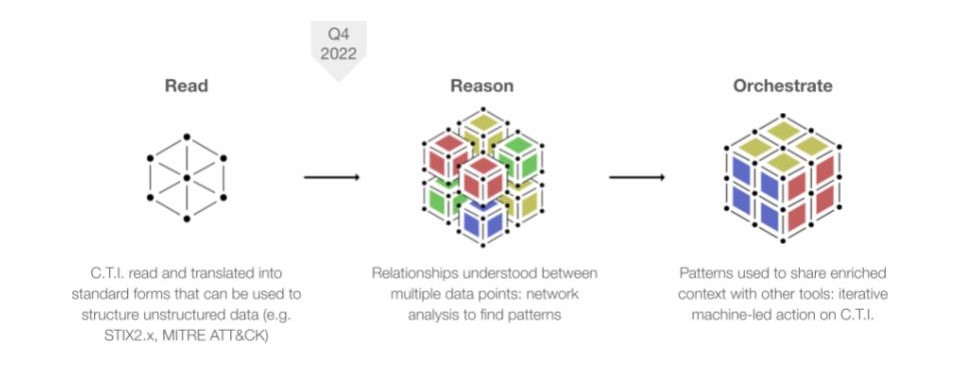At Elemendar we are on the cusp of celebrating our sixth birthday. This is a big thing! Both for a start-up and especially for a UK company like Elemendar; working within the Cyber Threat Intelligence (CTI) and broader security space. To celebrate this milestone and give a leg up to other UK start-ups that are following us, we have written this blog based on an interview with Elemendar’s three co-founders – Giorgos Georgopoulos (“G”), Syra Marshall and Devon Barrett. We hope you find this interesting and insightful.
Briefly, what is the history of Elemendar?
G – Our journey started in 2017 when the three Elemendar co-founders spent a few months in Cheltenham at the first NCSC and GCHQ start-up accelerator in the UK. Momentum started to build for us by the end of the Accelerator. With our first UK Government contract, this got us started with using Machine Learning (ML) to further our initial mission: adding structure to unstructured CTI data. We doubled down on R&D in 2018, which taught us an important lesson – that any ML model is only as good as the data you train it on.
Working to improve our models with a wider range of data sources, 2019 saw our first move into the private sector of CTI. We had landed ourselves with a data partnership with TIP industry leader EclecticIQ. Demonstrating our first successful models on both open-source and commercial threat intelligence then helped us be accepted for the LORCA programme. This began the expansion of our team, further broadening the skills within the company. 2020 started pretty exciting as we set about growing our ML team. I also set off on a global business development tour starting at the RSA Conference in San Francisco in February. This turned out to be unlucky timing to say the least! But, the team doubled down on the product and our efforts paid off at the end of the year, closing off with our first funding round.
2021 was a further landmark year for international expansion as we began our ongoing partnership with the US Government Laboratory for Analytic Sciences at NC State University. In 2022 we focused more closely on the security industry: developing our core technology READ.’s integrations with TIPs, SIEMs and SOAR platforms. The aim was to future proof our product with evolving industry standards. We then were able to return to the RSA conference with an official presence and a solid in-house team of CTI professionals.
Bringing us to 2023, the year has started in good form. With revenues crossing the £1m mark, more developments are on the roadmap for our READ. and REASON capabilities developing towards commercialisation.
What is Elemendar’s Goal?
Devon – All our products at Elemendar can be traced directly back to our time in the NCSC/ GCHQ Accelerator. This was where our mentor showed us a major problem: there was too much written threat intelligence and not enough analysts to read it. Since then we have developed and refined our core product READ. to address this problem. However, this is just the first step as we develop more complex AI-based systems that apply CTI to a broader range of security operations environments.

Figure 1: from READ. to Orchestrate, our future vision of Elemendar
As shown in our product vision above, now that READ. is performing adequately, we are starting to develop REASON. This uses graph analytics to infer new or missing objects and relationships.
What is the most challenging part of bringing an Artificial Intelligence based tool to the CTI market?
Syra – Any piece of technology that seeks to emulate an aspect of human cognition will have a degree of error within it. Simply because we, as humans, will transfer that error to the machine. This fact can be particularly hard to navigate during user acceptance trials with future clients. Many who, almost by default, are primed to expect any AI driven tool to deliver a perfect result. In reality any AI driven tool will have a degree of error – witness the often-horrifying AI generated art circulated on social media. However the key to success for operationalising any AI is dealing with this degree of error.
Tell us about Elemendar’s work culture and how it has evolved?
Devon – We are particularly proud of the diverse and inclusive culture we have created at Elemendar. With a strong representation of women and LGBTQI+ folk, Elemendar represents a wide variety of ages, ethnicities, educational backgrounds, and neurotype. While most tech companies are fully bought into DEI as a concept, it can be tough to realise in practise with pressures of hiring and retaining technically skilled employees. To date, we have both talked the talk and walked the walk and long may this continue.
Finally, where did the name Elemendar come from?
G – LOL, that is a great question! It came from a very rapid brainstorming session we had to run before a presentation at the Accelerator. Up until that point we didn’t actually have a name for what we were doing. IBM’s Watson for Cybersecurity had just launched and Syra loves a pun, so came up with a play on the famous phrase. Spoken by Sherlock Holmes “elementary my dear Watson” (though obviously a different Watson!), “Elementary” combined with “radar” quickly mutated into “Elemendar” and the rest was history!








